Radiation Effects in Tungsten and Tungsten-Copper Alloys Treated with Compression Plasma Flows and Irradiated with He Ions
Abstract
:1. Introduction
2. Materials and Methods
3. Results and Discussion
3.1. Compression Plasma Flows
3.2. Ion Irradiation of Tungsten and the Tungsten-Copper Alloy
4. Conclusions
Author Contributions
Funding
Institutional Review Board Statement
Informed Consent Statement
Data Availability Statement
Conflicts of Interest
References
- Li, Y.; Luo, G.; Sun, Y.; Zhang, J.; Shen, Q.; Zhang, L. Microstructure and Mechanical Properties Investigation of W Cu Composites Prepared from Dual-Layer Coated Powders. Appl. Surf. Sci. 2020, 516, 146098. [Google Scholar] [CrossRef]
- Qiu, W.T.; Pang, Y.; Xiao, Z.; Li, Z. Preparation of W-Cu Alloy with High Density and Ultrafine Grains by Mechanical Alloying and High Pressure Sintering. Int. J. Refract. Met. Hard Mater. 2016, 61, 91–97. [Google Scholar] [CrossRef]
- Wei, B.; Zhou, R.; Xu, D.; Chen, R.; Yu, X.; Chen, P.; Cheng, J. Continuous W-Cu Functional Gradient Material from Pure W to W-Cu Layer Prepared by a Modified Sedimentation Method. Nucl. Eng. Technol. 2022, 54, 4491–4498. [Google Scholar] [CrossRef]
- Wang, Y.; Zhuo, L.; Yin, E. Progress, Challenges and Potentials/Trends of Tungsten-Copper (W Cu) Composites/Pseudo-Alloys: Fabrication, Regulation and Application. Int. J. Refract. Met. Hard Mater. 2021, 100, 105648. [Google Scholar] [CrossRef]
- Zhang, Q.; Liang, S.; Hou, B.; Zhuo, L. The Effect of Submicron-Sized Initial Tungsten Powders on Microstructure and Properties of Infiltrated W-25wt.% Cu Alloys. Int. J. Refract. Met. Hard Mater. 2016, 59, 87–92. [Google Scholar] [CrossRef]
- Burtscher, M.; Alfreider, M.; Kainz, C.; Schmuck, K.; Kiener, D. In Situ Micromechanical Analysis of a Nano-Crystalline W-Cu Composite. Mater. Des. 2022, 220, 110848. [Google Scholar] [CrossRef]
- Ma, E. Alloys Created between Immiscible Elements. Prog. Mater. Sci. 2005, 50, 413–509. [Google Scholar] [CrossRef]
- Chen, W.; Dong, L.; Zhang, H.; Song, J.; Deng, N.; Wang, J. Microstructure Characterization of W-Cu Alloy Sheets Produced by High Temperature and High Pressure Deformation Technique. Mater. Lett. 2017, 205, 198–201. [Google Scholar] [CrossRef]
- Zhuo, L.; Zhang, J.; Zhang, Q.; Wang, H.; Zhao, Z.; Chen, Q.; Liang, S.; Xu, J.; Xi, A. Achieving Both High Conductivity and Reliable High Strength for W–Cu Composite Alloys Using Spherical Initial Powders. Vacuum 2020, 181, 109620. [Google Scholar] [CrossRef]
- Zhang, X.; Mei, X.; Wang, Y.; Wang, Y.; Sun, J. The Study of Irradiation Damage Induced by Proton in Metallic Glass Ni62Ta38 and Metal W. Nucl. Instrum. Methods Phys. Res. Sect. B Beam Interact. Mater. At. 2018, 436, 1–8. [Google Scholar] [CrossRef]
- Harrison, R.W.; Greaves, G.; Hinks, J.A.; Donnelly, S.E. A Study of the Effect of Helium Concentration and Displacement Damage on the Microstructure of Helium Ion Irradiated Tungsten. J. Nucl. Mater. 2017, 495, 492–503. [Google Scholar] [CrossRef]
- Yu, J.; Han, W.; Chen, Z.; Zhu, K. Blistering of Tungsten Films Deposited by Magnetron Sputtering after Helium Irradiation. Fusion Eng. Des. 2018, 129, 230–235. [Google Scholar] [CrossRef]
- Xu, M.-Y.; Luo, L.-M.; Zhou, Y.-F.; Zan, X.; Xu, Y.; Xu, Q.; Tokunaga, K.; Zhu, X.-Y.; Wu, Y.-C. Helium Irradiation Behavior of Tungsten-Niobium Alloys under Different Ion Energies. Fusion Eng. Des. 2018, 132, 7–12. [Google Scholar] [CrossRef]
- Khripunov, V. First Wall Material Damage Induced by Fusion-Fission Neutron Environment. Fusion Eng. Des. 2016, 109–111, 7–12. [Google Scholar] [CrossRef]
- Uglov, V.V.; Kvasov, N.T.; Remnev, G.E.; Shymanski, V.I.; Korenevski, E.L.; Zlotski, S.V.; Abadias, G.; O’Connel, J.; Van Vuuren, A. Size Effect in AlN/SiN Multilayered Films Irradiated with Helium and Argon Ions. Nucl. Instrum. Methods Phys. Res. Sect. B Beam Interact. Mater. At. 2018, 435, 228–235. [Google Scholar] [CrossRef]
- Coenen, J.W.; Berger, M.; Demkowicz, M.J.; Matveev, D.; Manhard, A.; Neu, R.; Riesch, J.; Unterberg, B.; Wirtz, M.; Linsmeier, C. Plasma-Wall Interaction of Advanced Materials. Nucl. Mater. Energy 2017, 12, 307–312. [Google Scholar] [CrossRef]
- Budaev, V.P.; Martynenko, Y.V.; Grashin, S.A.; Giniyatulin, R.N.; Arkhipov, I.I.; Karpov, A.V.; Savrukhin, P.V.; Shestakov, E.A.; Solomatin, R.Y.; Begrambekov, L.B.; et al. Tungsten Melting and Erosion under Plasma Heat Load in Tokamak Discharges with Disruptions. Nucl. Mater. Energy 2017, 12, 418–422. [Google Scholar] [CrossRef]
- Tejado, E.; Dias, M.; Correia, J.B.; Palacios, T.; Carvalho, P.A.; Alves, E.; Pastor, J.Y. New WC-Cu Thermal Barriers for Fusion Applications: High Temperature Mechanical Behaviour. J. Nucl. Mater. 2018, 498, 355–361. [Google Scholar] [CrossRef]
- Ryskulov, A.; Shymanski, V.; Uglov, V.; Ivanov, I.; Astashynski, V.; Amanzhulov, B.; Kuzmitski, A.; Kurakhmedov, A.; Filipp, A.; Ungarbayev, Y.; et al. Structure and Phase Composition of WNb Alloy Formed by the Impact of Compression Plasma Flows. Materials 2023, 16, 4445. [Google Scholar] [CrossRef]
- Shymanski, V.I.; Jevdokimovs, A.; Cherenda, N.N.; Astashynski, V.M.; Petrikova, E.A. Structure and phase composition of hypereutectic silumin alloy Al-20Si after compression plasma flows impact. J. Belarusian State Univ. Phys. 2021, 2, 25–33. [Google Scholar] [CrossRef]
- Uglov, V.V.; Anishchik, V.M.; Kvasov, N.T.; Petukhou, Y.A.; Astashynski, V.M.; Kuzmitski, A.M. Structural and Phase Changes in Iron-on-Silicon Treated by Compression Plasma Flows. Vacuum 2009, 83, 1152–1154. [Google Scholar] [CrossRef]
- Shymanski, V.I.; Cherenda, N.N.; Uglov, V.V.; Astashynski, V.M.; Kuzmitski, A.M. Structure and Phase Composition of Nb/Ti System Subjected to Compression Plasma Flow Impact. Surf. Coat. Technol. 2015, 278, 183–189. [Google Scholar] [CrossRef]
- Wei, W.; Wu, C.Y.; Fan, J.L.; Gong, H.R. Fundamental effects of copper on dislocation loops and mechanical property of tungsten under irradiation. J. Nucl. Mater. 2021, 548, 152838. [Google Scholar] [CrossRef]
- Anishchik, V.M.; Uglov, V.V.; Astashynski, V.V.; Astashynski, V.M.; Ananin, S.I.; Kostyukevich, E.A.; Kuzmitski, A.M.; Kvasov, N.T.; Danilyuk, A.L.; Rumianceva, I.N. Compressive Plasma Flows Interaction with Steel Surface: Structure and Mechanical Properties of Modified Layer. Vacuum 2003, 70, 269–274. [Google Scholar] [CrossRef]
- Uglov, V.V.; Anishchik, V.M.; Astashynski, V.V.; Astashynski, V.M.; Ananin, S.I.; Askerko, V.V.; Kostyukevich, E.A.; Kuz’mitski, A.M.; Kvasov, N.T.; Danilyuk, A.L. The Effect of Dense Compression Plasma Flow on Silicon Surface Morphology. Surf. Coat. Technol. 2002, 158–159, 273–276. [Google Scholar] [CrossRef]
- Shymanski, V.I.; Uglov, V.V.; Cherenda, N.N.; Pigasova, V.S.; Astashynski, V.M.; Kuzmitski, A.M.; Zhong, H.W.; Zhang, S.J.; Le, X.Y.; Remnev, G.E. Structure and Phase Composition of Tungsten Alloys Modified by Compression Plasma Flows and High-Intense Pulsed Ion Beam Impacts. Appl. Surf. Sci. 2019, 491, 43–52. [Google Scholar] [CrossRef]
- Zdorovets, M.; Ivanov, I.; Koloberdin, M.; Kozin, S.; Alexandrenko, V.; Sambaev, E.; Kurakhmedov, A.; Ryskulov, A. Accelerator Complex Based on DC-60 Cyclotron. In Proceedings of the 24th Russian Particle Accelerator Conference, Obninsk, Kaluga Region, Russia, 6–10 October 2014; pp. 287–289. [Google Scholar]
- Ziegler, J.F.; Ziegler, M.D.; Biersack, J.P. SRIM—The Stopping and Range of Ions in Matter (2010). Nucl. Instrum. Methods Phys. Res. Sect. B Beam Interact. Mater. At. 2010, 268, 1818–1823. [Google Scholar] [CrossRef]
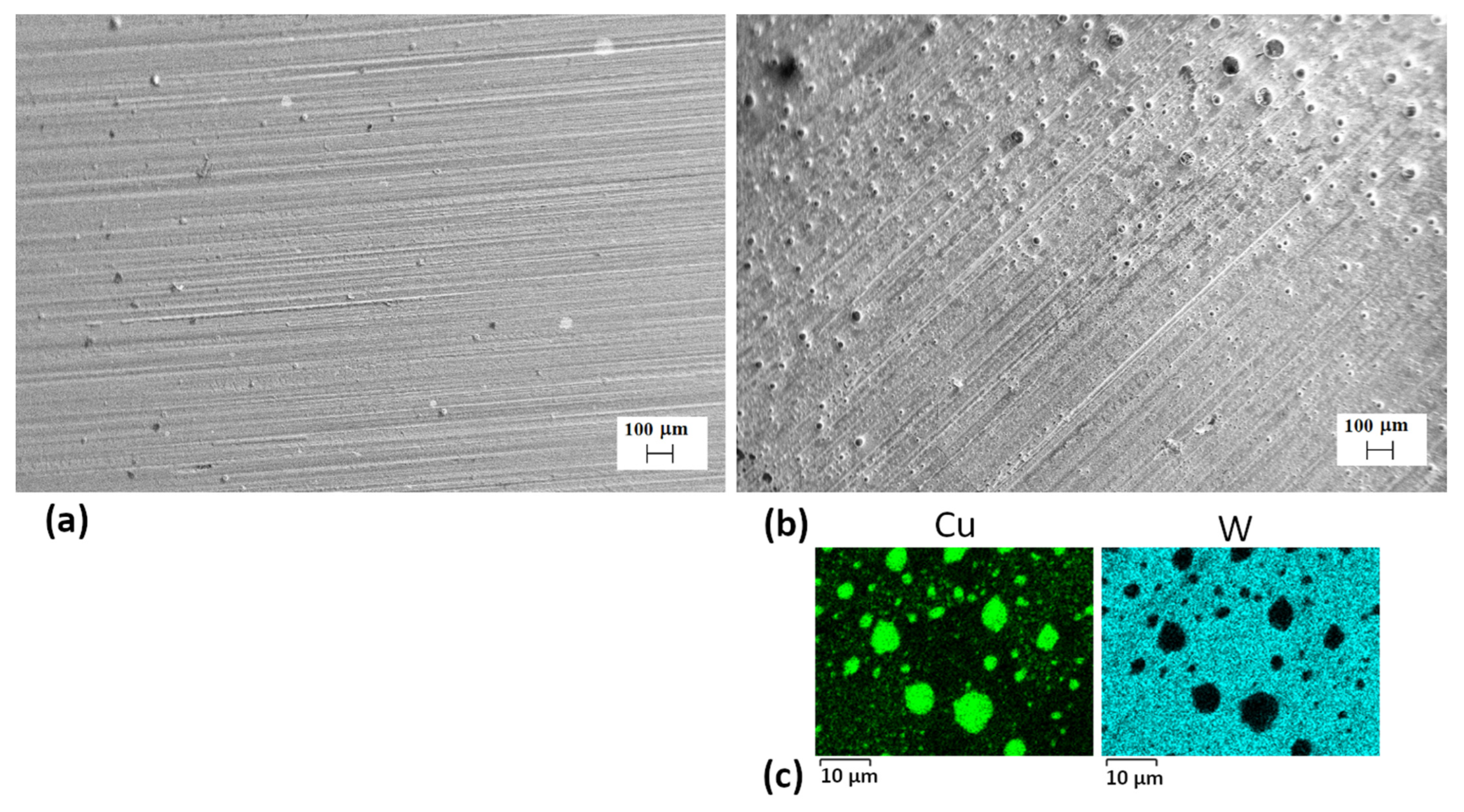
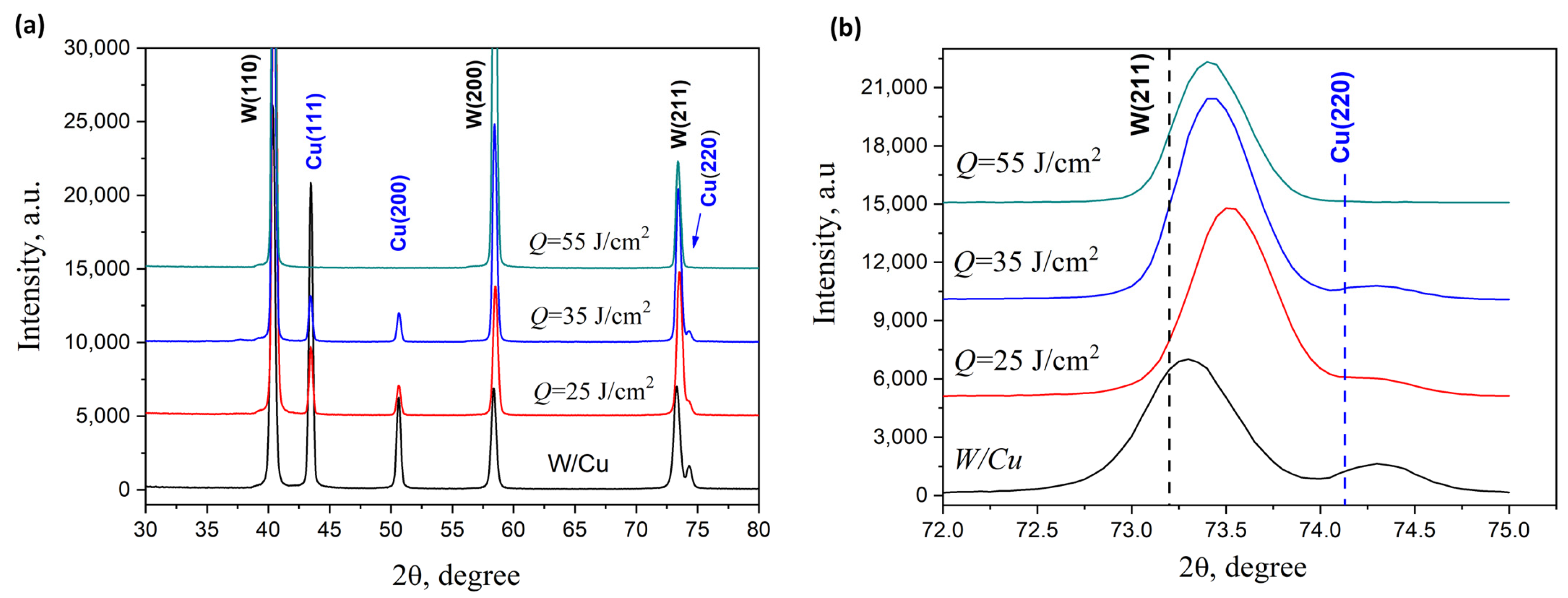


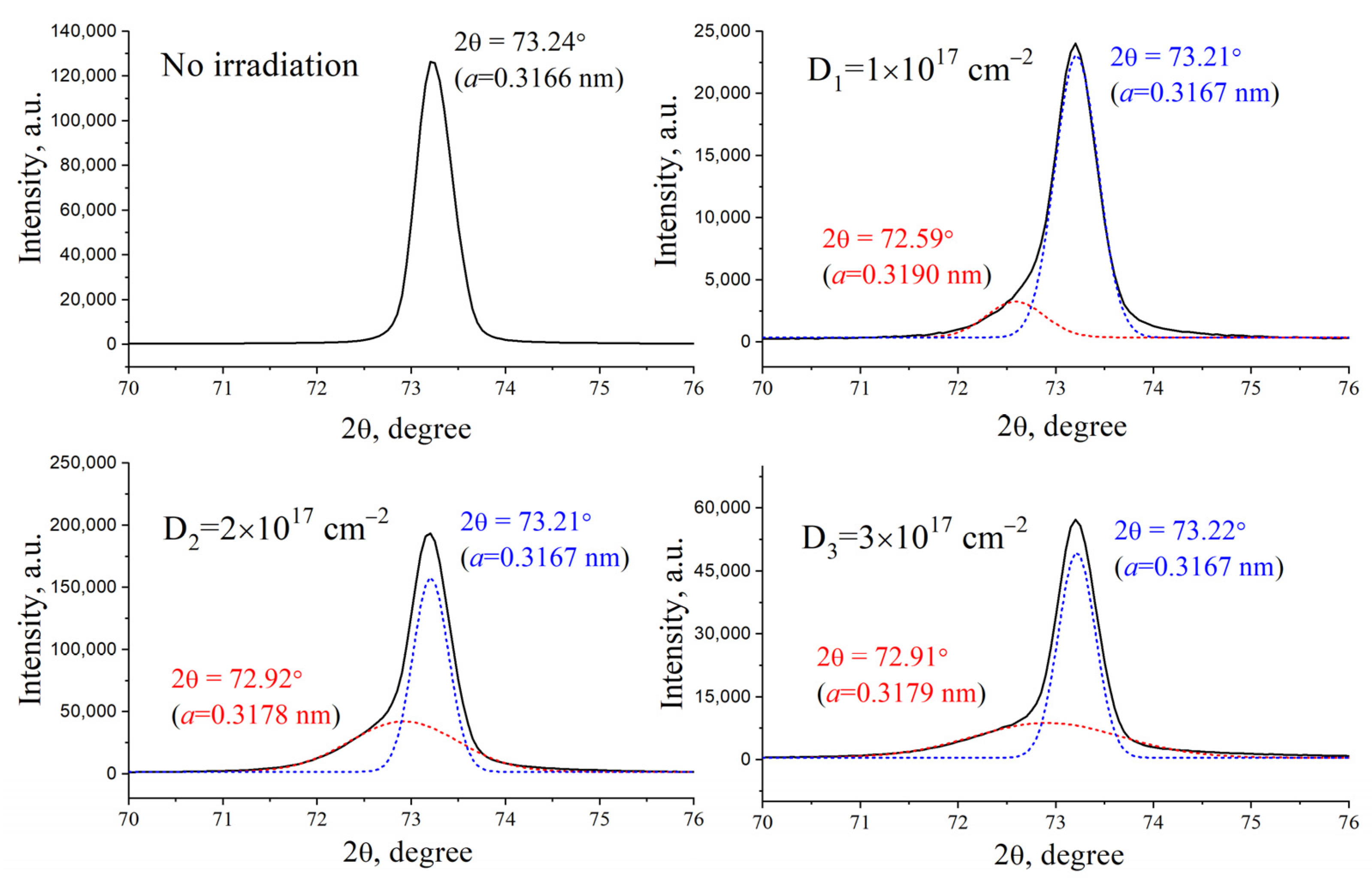
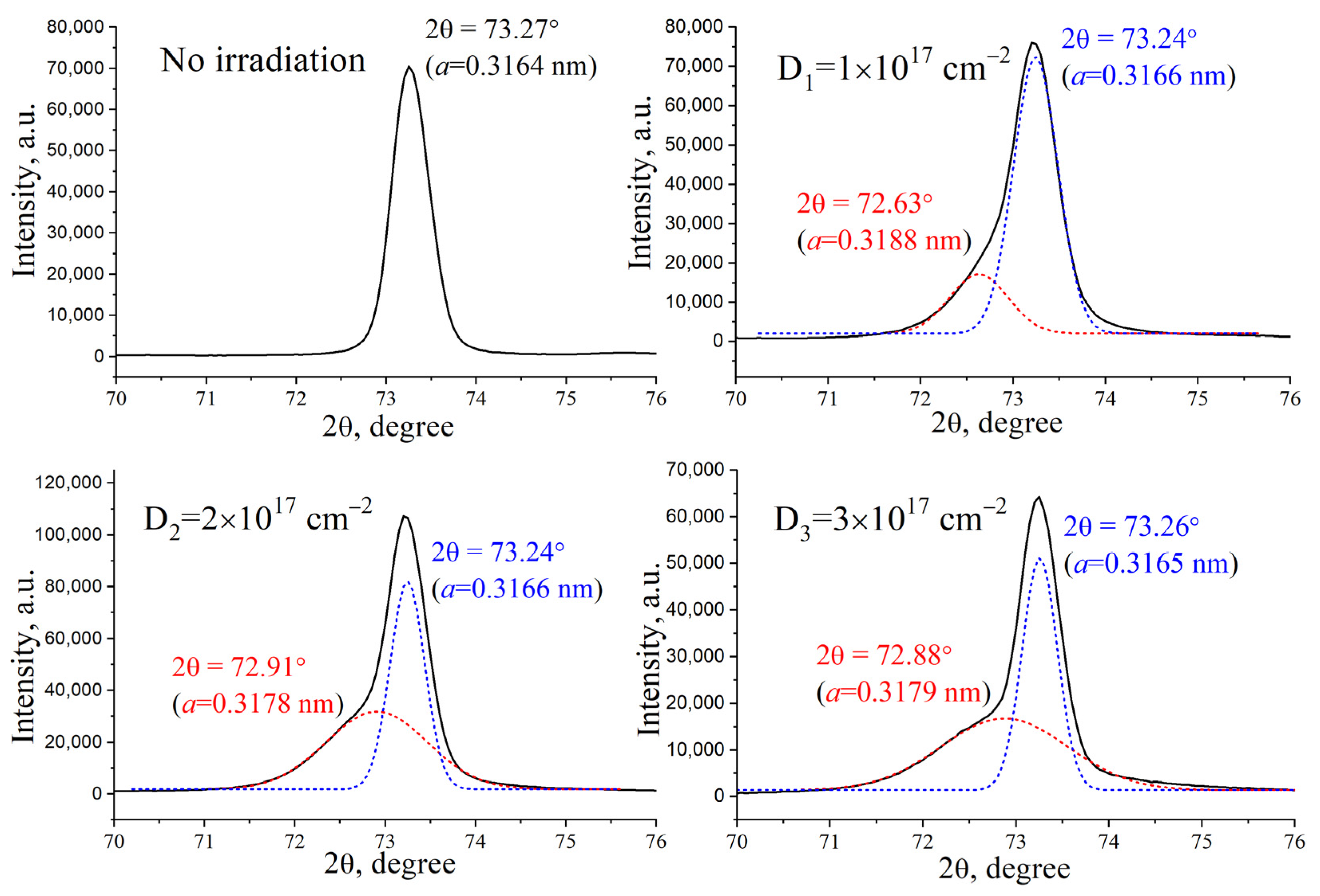

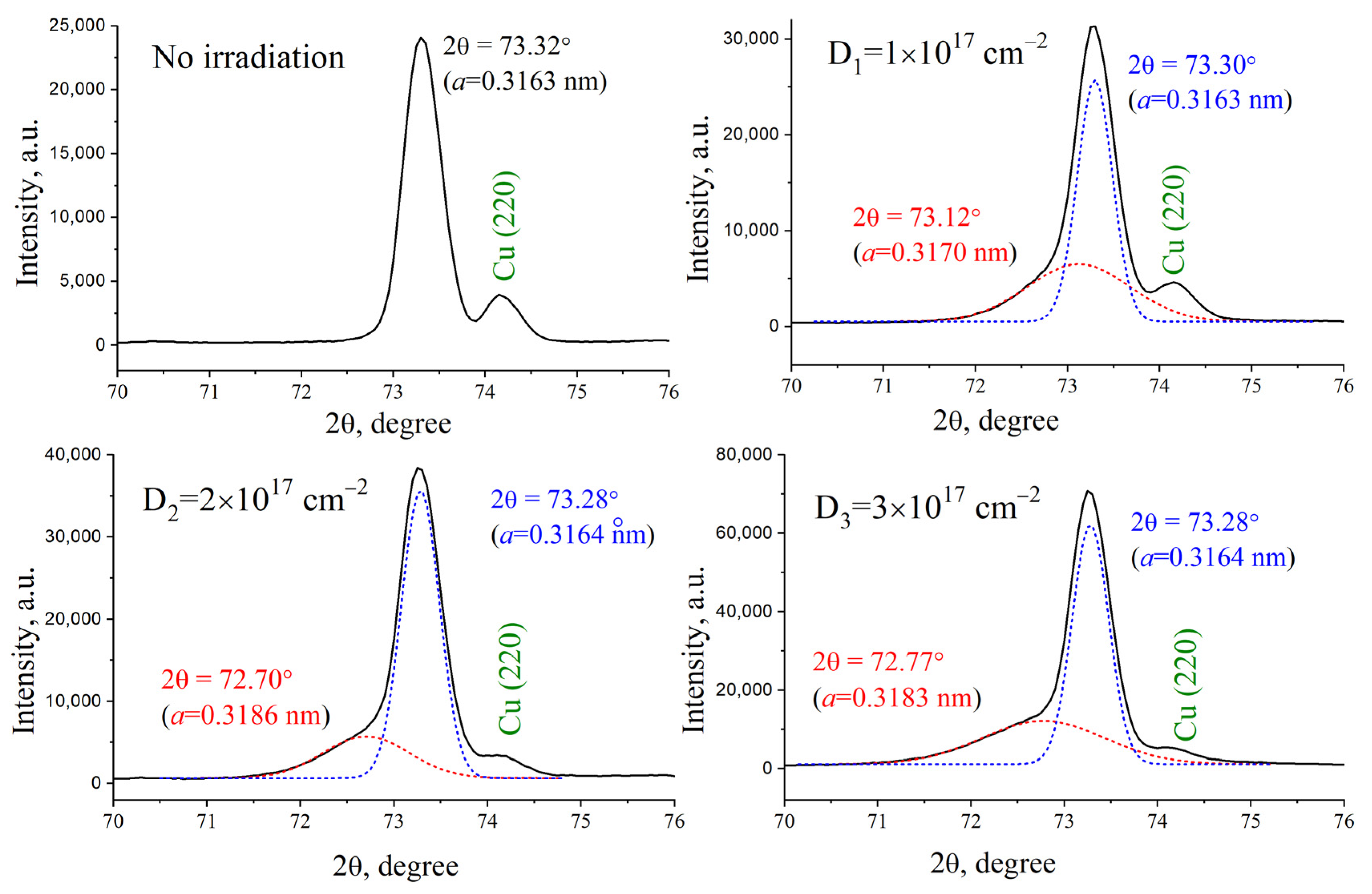
| Ions | Energy, keV | Temperature of Irradiation, °C | Flux, cm−2·s−1 | Irradiation Time | Fluence, cm−2 |
|---|---|---|---|---|---|
| He2+ | 40 | 25 | 9.11 × 1012 | 3 h 3 min | 1 × 1017 |
| He2+ | 40 | 25 | 1.10 × 1013 | 5 h 2 min | 2 × 1017 |
| He2+ | 40 | 25 | 1.05 × 1013 | 7 h 57 min | 3 × 1017 |
Disclaimer/Publisher’s Note: The statements, opinions and data contained in all publications are solely those of the individual author(s) and contributor(s) and not of MDPI and/or the editor(s). MDPI and/or the editor(s) disclaim responsibility for any injury to people or property resulting from any ideas, methods, instructions or products referred to in the content. |
© 2024 by the authors. Licensee MDPI, Basel, Switzerland. This article is an open access article distributed under the terms and conditions of the Creative Commons Attribution (CC BY) license (https://creativecommons.org/licenses/by/4.0/).
Share and Cite
Ryskulov, A.; Shymanski, V.; Ivanov, I.; Amanzhulov, B.; Dauhaliuk, A.; Uglov, V.; Temir, A.; Astashynski, V.; Sapar, A.; Kuzmitski, A.; et al. Radiation Effects in Tungsten and Tungsten-Copper Alloys Treated with Compression Plasma Flows and Irradiated with He Ions. Materials 2024, 17, 4442. https://doi.org/10.3390/ma17184442
Ryskulov A, Shymanski V, Ivanov I, Amanzhulov B, Dauhaliuk A, Uglov V, Temir A, Astashynski V, Sapar A, Kuzmitski A, et al. Radiation Effects in Tungsten and Tungsten-Copper Alloys Treated with Compression Plasma Flows and Irradiated with He Ions. Materials. 2024; 17(18):4442. https://doi.org/10.3390/ma17184442
Chicago/Turabian StyleRyskulov, Azamat, Vitaliy Shymanski, Igor Ivanov, Bauyrzhan Amanzhulov, Anastasia Dauhaliuk, Vladimir Uglov, Adilet Temir, Valiantsin Astashynski, Asset Sapar, Anton Kuzmitski, and et al. 2024. "Radiation Effects in Tungsten and Tungsten-Copper Alloys Treated with Compression Plasma Flows and Irradiated with He Ions" Materials 17, no. 18: 4442. https://doi.org/10.3390/ma17184442






